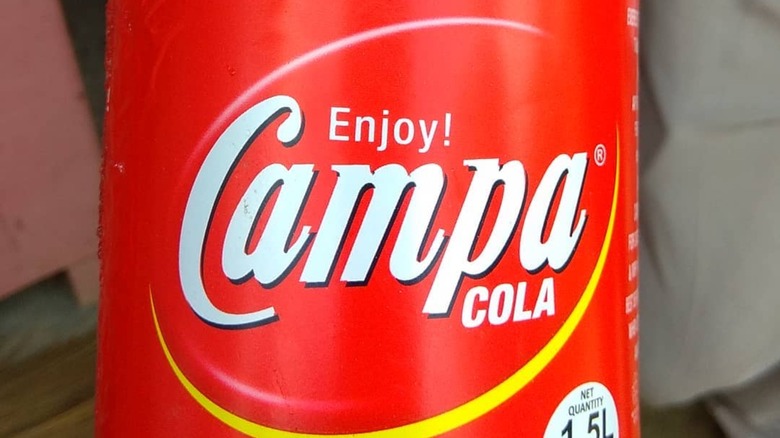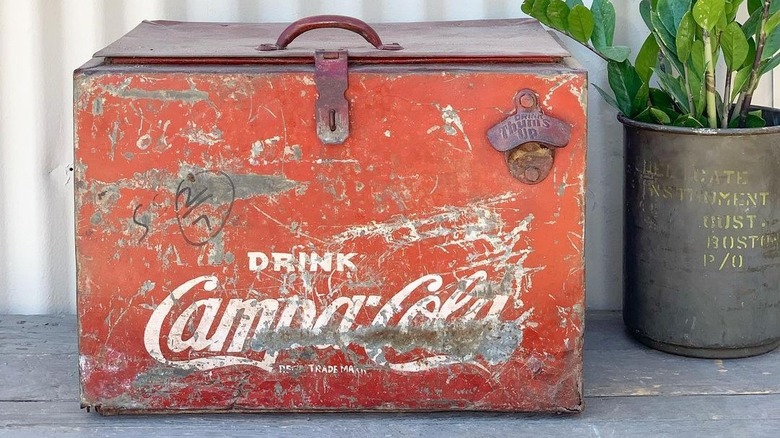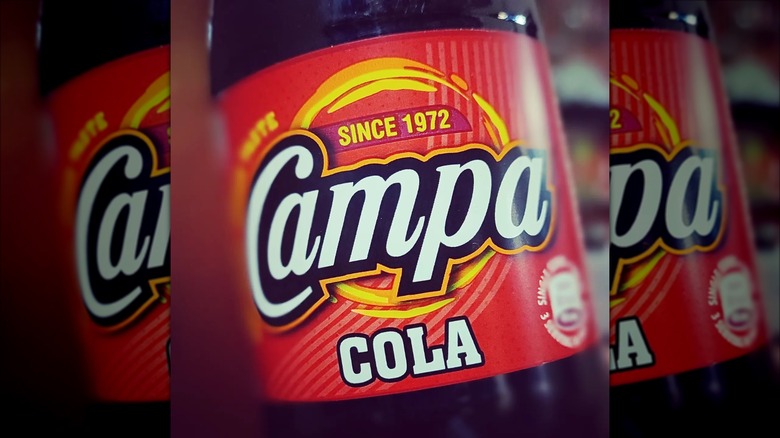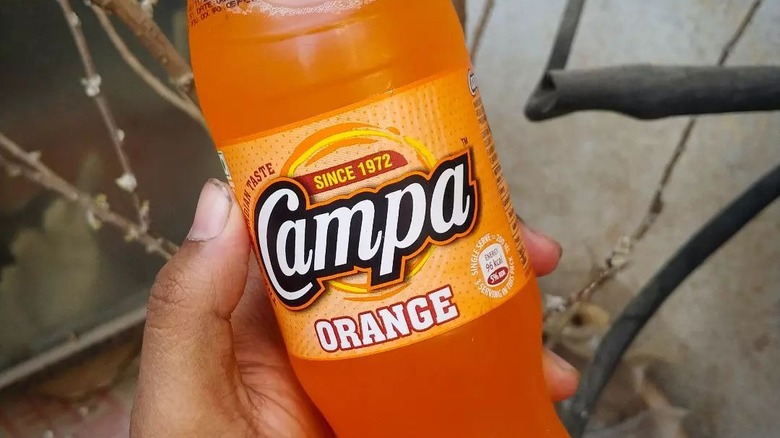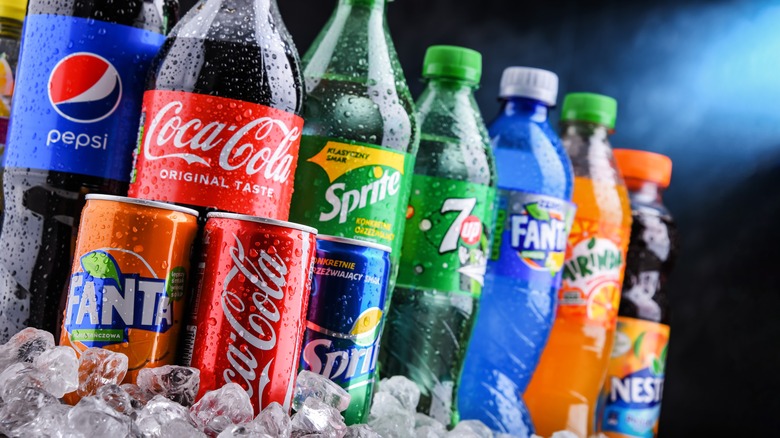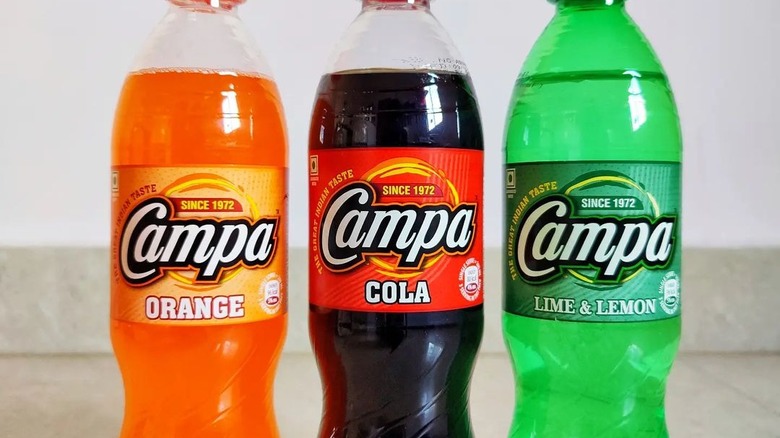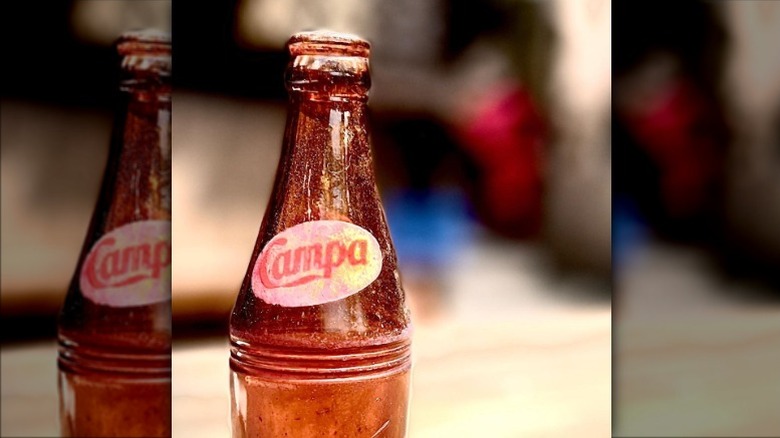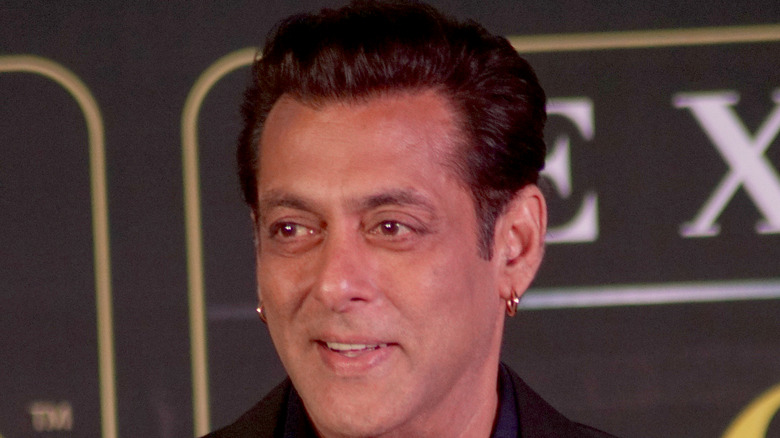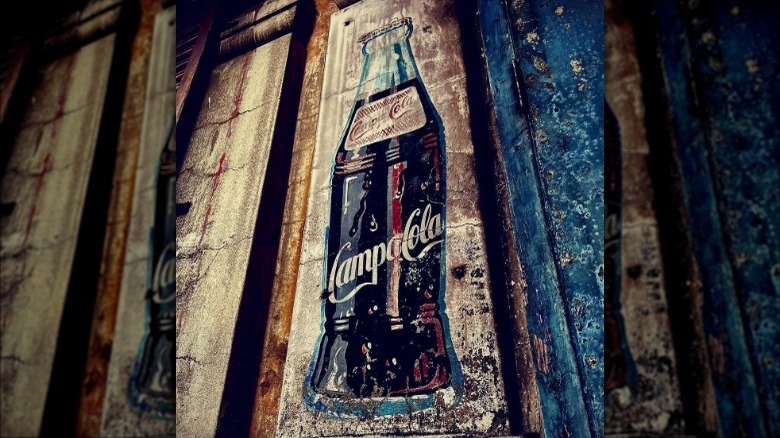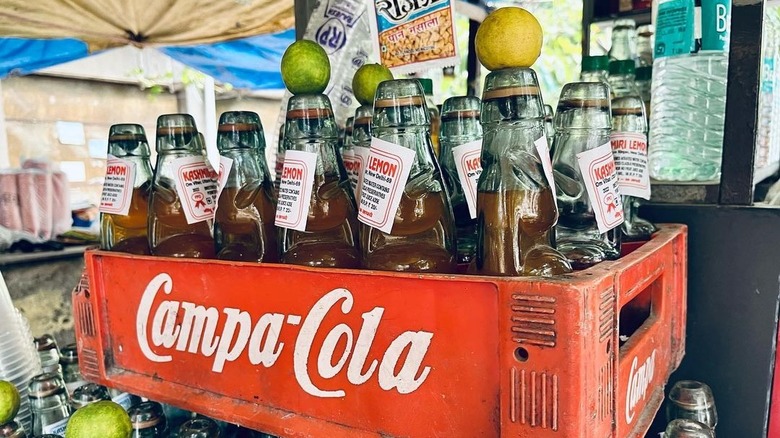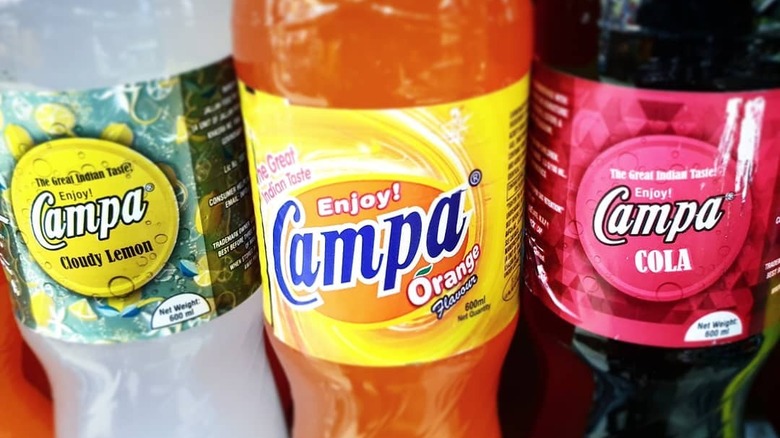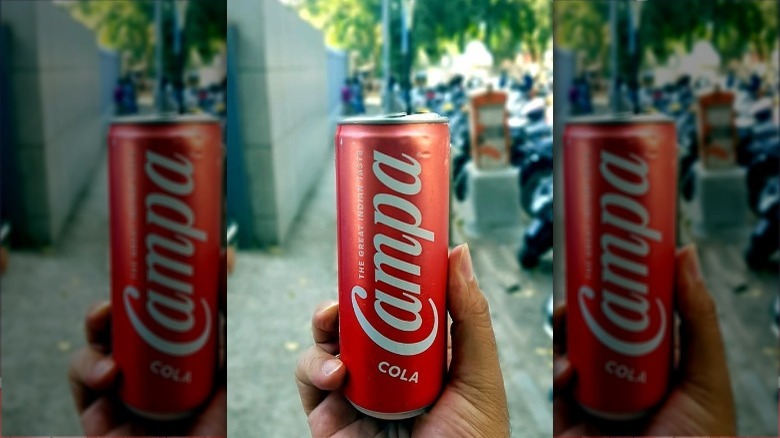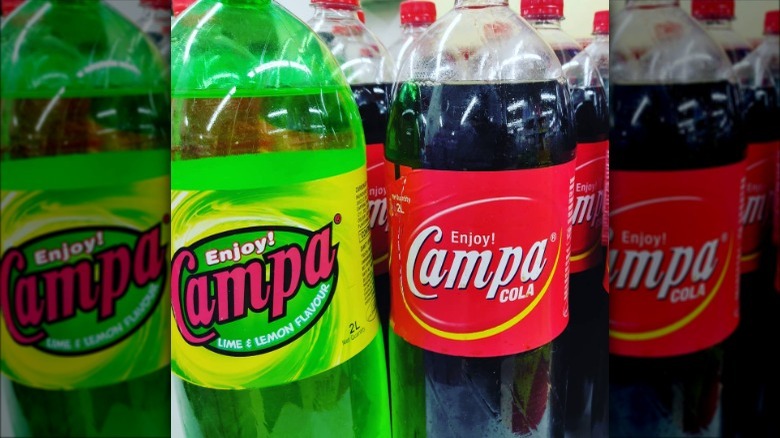Campa Cola: 12 Facts About The Old School Soft Drink That's Making A Comeback
Many countries pride themselves on iconic drinks that define national culture and identity. In England, a well-made pot of tea still evokes the country's colonial history and reverence for ritual. In the U.S., a cold bottle of Coke represents our spirit of entrepreneurship (let's turn a medicinal elixir into a global sensation!) and shameless love of sweets. For those who grew up in India in the late 1970s, few drinks evoke a sense of home and youthful socializing like Campa Cola, a once nearly ubiquitous soft drink known for its colorful, youthful ads as much as its flavor.
But compared to India's long history, Campa Cola's day in the sun was relatively short. First launched in 1977, the brand lost its luster in the 1990s and finally closed its operations in Delhi by the 2000s. Still, Campa Cola continued to limp along and kept bottling small quantities of its iconic cola in another facility.
While many assumed the drink's time had come and gone, it's now getting a second life. The brand has been purchased from its original manufacturers by the Reliance Group, a major Indian business conglomerate, and has been relaunched with refreshed branding. Here's what you need to know about the past, present, and future of this Indian favorite.
It was developed and introduced by India's Coca-Cola distributor
Prior to 1977, Coca-Cola was the reigning cola in the Indian market. But a new set of protectionist policies enacted in India in 1977 imposed restrictions on foreign businesses that Coca-Cola found unacceptable, such as the requirement that the foreign company reveal its famously secret formula. Rather than do the unthinkable, Coca-Cola abruptly exited the Indian market. That left its sole Indian distributor, Pure Drinks, with several empty factories, thousands of employees with nothing to do, and lots of cola-making supplies.
Pure Drinks quickly realized Coca-Cola's exit gave it an opportunity to fill the void. "My grandfather [Pure Drinks executive] S. Daljit Singh decided that we should launch our own soft drink brand with locally developed concentrate — Campa — to fill the space in the market and utilise our resources," Jaywantjit Singh, told Condè Nast Traveller.
Campa Cola wasn't the only homegrown soft drink to rush into the void left by Coca-Cola. Around this time, the Indian government introduced its own soft drink, Double Seven (representing the year of Coca-Cola's departure), while another company launched Thums Up. Double Seven proved to be a flop while Thums Up continues to be popular in India.
Campa Cola started as a shameless imitation of Coca-Cola
As India's designated manufacturer and distributor of Coca-Cola, Pure Drinks became quite adept at making the beverage. So, when Coca-Cola made the sudden decision to pull out of the Indian market in 1977, Pure Drinks decided to launch Campa Cola to replace it. The company did what it already knew how to do: Make Coca-Cola, only with a homegrown flavorings in place of Coca-Cola's proprietary formula.
Pure Drinks didn't make any attempt to hide the similarities between Campa Cola and Coca-Cola, and indeed seemed to blatantly capitalize on them. The original Campa Cola logo featured the same brush script used on the Coca-Cola label, while the bottles were the same curvy, slender glass forms then used by Coca-Cola. There was even originally a hyphen between "Campa" and "Cola."
The taste was close enough to the original to satisfy the cravings of its captive audience. "Campa tasted good — because we didn't have any other options," Santosh Desai, a Times of India writer, told The New York Times.
Campa Cola marketed itself as proudly and uniquely Indian
While Campa Cola was a blatantly obvious imitation of Coca-Cola and by most accounts looked and tasted like a regular American cola, it was marketed as a distinctly Indian product. Ads for Campa Cola used the tagline "The Great Indian Taste." Yet its closest domestic competitor, Thums Up, actually does boast a more distinctly Indian flavor profile, incorporating a masala mix into its flavor base.
Campa Cola's patriotic branding was likely more motivated by the nationalistic mood of late 1970s India than any claim to being a distinctly Indian product. The government regulations that drove Coca-Cola from India during this time were meant to make India self-sufficient and build its economy on domestically made products like cars, movies, and soda. Campa Cola, despite its close resemblance and historical relationship with Coca-Cola, could proudly claim to be a homegrown product made by Indians, for Indians.
The brand fizzled after Coca-Cola and Pepsi were reintroduced into India
When Campa Cola first launched in 1977, it was an immediate hit. With the sudden departure of Coca-Cola from the Indian market, many consumers were excited and grateful to have a close substitute. Indeed, much of Campa's initial appeal wasn't unique flavor or branding, but its similarity to the much-missed Coca-Cola. Branding experts have even called it an "imitation" brand and attributed much of the drink's success to this quality.
For a while, this worked out well for Campa Cola, which developed its own brand image and an aggressive marketing strategy. It also had little to no direct competition, as Indian-made Thums Up, another popular soft drink that emerged during this time, had a distinct flavor profile and wasn't directly comparable.
All this changed when India opened its markets to foreign goods again in the 1990s. With the Indian government's encouragement, Coca-Cola returned and Pepsi entered the market soon after. Both launched well-funded advertising campaigns, and Indian consumers quickly decided they'd rather have "the real thing" than a homegrown imitation. To add insult to injury, Coca-Cola then sued Campa Cola for adopting its bottle design. By 2000, Campa Cola had closed most of its factories and slowed its manufacturing to a trickle.
It was known for its colorful advertisements
While the manufacturers of Campa Cola knew they had a captive audience when they launched the drink, they weren't taking any chances. They unrolled an aggressive advertising campaign that targeted young people. One of its best-known ads featured a cheerful group of teens lounging on (and diving from) a yacht, then relaxing on the beach as one of them played the guitar — all while guzzling copious quantities of Campa Cola.
The company's colorful print ads followed this general theme, highlighting Campa Cola as a core part of socializing. Many featured groups of happy young people hanging out together while enjoying the drink, with taglines like "Life is full of Campa Cola times" (presumably, these times included partying rather than cramming for exams or washing dishes) and "We're all in it together for the fun of it, for the taste of it." These ads quickly cemented Campa Cola in the public imagination as a must-have for socializing and celebration.
Campa Cola became a big part of Indian youth culture
In its early days, Campa Cola's youth-focused advertising campaign worked as expected and the drink quickly became a favorite among children and teenagers. For young Indians in the late 1970s and 1980s, it was soon associated with birthday parties, carefree vacations, and special occasions such as the completion of school exams. Today, Campa Cola's now grown-up fans remember it as a special and comforting part of their childhood. "Campa was the drink that we associated with innocence, good times and fun with friends. When I think of my childhood, it was always there, like a friend itself," marketer Rohini Mathur told Condè Nast Traveller.
Its kid-friendly flavor also contributed to its popularity. Some fans recalled that it was sweeter, more mildly flavored, and less aggressively carbonated than other soft drinks available at the time, which made it the drink of choice for young palates. "At that time, Thums Up was this very adult kind of drink. I remember having it once and reacting to it almost the way teenagers react to their first beer," John Thangaraj told Condè Nast Traveller. "Campa just felt more reassuring and friendly."
Bollywood star Salman Khan launched his career with a Campa Cola ad
Campa Cola's ads were shamelessly aspirational, seeming to send the message that drinking it would ensure a life full of fun, friendship, and adventure. One ad featured a group of teens lounging cheerily on a yacht (probably not part of the everyday lived experience of most Indian kids in the 1980s) and swimming in tropical waters before settling on a pristine white beach for an evening of camping and, of course, Campa Cola.
This particular ad not only encouraged viewers to dream of a life of glamor and adventure but actually launched one. Featured in the ad and singing its catchy jingle was a handsome, then-unknown 15-year-old actor named Salman Khan in his first broadcast appearance. Khan would go on to appear in over 60 films, becoming one of Bollywood's biggest and wealthiest stars, earning a reported $33.5 million in 2015. But as much as his career has grown, he hasn't moved far from his initial gig as a soda pitchman. After rising to Bollywood prominence (and long after the demise of Campa Cola), he briefly became a spokesman for another popular Indian soft drink, Thums Up.
It's being relaunched by Asia's richest man
After Coca-Cola re-entered the Indian market, Campa Cola quickly fell from favor. But even after it was forced to close most of its factories, manufacturer Pure Drinks refused to give up on the brand. But though it made several attempts to reboot the brand over the years, all these attempts failed due to a lack of funding.
Campa Cola then got a new lease on life when the Reliance Group, a large Indian business conglomerate, bought the Campa Cola brand from Pure Drinks. The difference: the Reliance Group is owned by Mukesh Ambani, Asia's richest man as of 2023.
Ambani, who took over part of the Reliance Group from his father (his brother was given charge of the other part), boosted the group's gas, oil, and petrochemicals holdings by building the world's biggest startup petroleum refinery along with numerous manufacturing centers. Reliance's holdings also now include a network of retail outlets along with interests in consumer goods. "What Reliance will now do for them is probably provide more physical real estate for the product in their own stores. They have also said they want to push their products in general trade," Varund Singh, assistant vice president of IBDI Capital, told Outlook.
Here's why Campa Cola is coming back
The Reliance Group's decision to relaunch Campa Cola wasn't a mere whim driven by nostalgia, but a strategic business decision meant to bolster the group's other interests. The organization recently decided to move into the fast-moving consumer goods market and chose the well-known Campa Cola brand as its first brand in this sector.
Analysts think Reliance had several motivations behind this choice. First, soda is inexpensive to produce, as it's mostly water, sugar, and flavorings, with most major brands spending more on marketing. With its deep pockets, Reliance has the resources to aggressively market the brand to both adults who grew up with it as well as younger consumers.
"Campa Cola is already familiar to most Indians. [After] revitalizing it with a lot of advertising budget that a brand like Reliance brings to the table that it did not have earlier, it is very much possible that Pepsi and Coke could find it difficult to compete," marketing analyst Avinash Gorakshakar told Outlook.
Cola was just one of several Campa soft drinks
While Campa Cola was Pure Drinks' signature offering when it began manufacturing its own soda brand, it also offered several other flavors under the Campa label. Campa Orange and Campa Lemon were introduced at the same time as Campa Cola, and while neither attained the popularity of the cola (which made up 80% of the company's sales), both had their loyal fans, as well as dedicated advertising campaigns.
Other flavors later added to the mix included clear lemon, apple, and jeera (cumin), a spice used in other Indian soda brands. Campa Jeera appears to be a very late addition launched in 2016, well after Campa Cola had been reduced to a niche brand. Under its new ownership, the relaunched Campa lineup will offer the three original flavors — Campa Cola, Campa Lemon, and Campa Orange — with the company hinting at the possibility of additional flavors to come.
Nostalgia is a big part of Campa Cola's relaunch
An advantage of re-introducing the brand is that Campa Cola is already a well-known and beloved entity to Indians of a certain age. The brand now has a completely new and modernized look — it will be sold in cans and plastic bottles instead of glass, while its colorful new labels and typeface no longer bear any resemblance to Coca-Cola. However, its original tagline, "The Great Indian Taste," will remain.
While some observers wonder if the Campa Cola experience will feel as satisfying now as it does in memory, many of the drink's old fans are eager to re-experience a part of their youth. "If it tastes anything like it did, Campa Cola will sell on nostalgia," one fan wrote on Twitter (per CNN). And for other fans, the relaunch is bringing back a flood of memories, like drinking Campa Cola for courage and comfort before asking a girl out on a date or showing a bad report card to one's parents.
But the Reliance Group thinks that the rebooted drink will also win new fans on its own merits. "While older family members will have fond memories of the original Campa and cherish the nostalgia associated with the brand, younger consumers will love the crisp refreshing taste, " a Reliance spokesperson told The Times of India.
It's not clear if Campa Cola will be sold internationally
When the Reliance Group relaunched Campa Cola in 2022, it had a few key strategies in mind: promote the brand to nostalgic fans and ensure it can compete against major American competitors. As part of its effort to control prices, it initially sold the drinks exclusively through its own retail outlets. However, Reliance is said to be planning to expand the brand to more general sales venues.
However, the rollout of Campa Cola seems to be taking place at an intentionally slow rate. So far, it's not even available everywhere in India. So for now, it appears that Reliance is focusing on making sure that Campa Cola conquers the domestic market rather than achieving immediate world domination. This means that curious soda mavens from outside India and expatriates wanting to recapture a bit of their childhood will have to wait to get a taste — or travel to India to find some.
